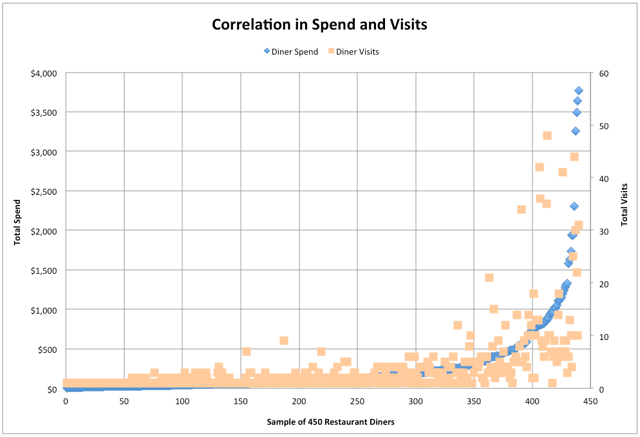

Stay tuned to the latest in restaurant Ops & Marketing. We email 2-3 times per month.

When designing a Rewards Program, there are only so many measures to judge a guest's loyalty to your business. The two most common are visits and spend.
Which is right for your business?
The short of it: In full-service restaurants, visit-based programs outperform spend-based programs, because the main goal of a rewards program is to increase frequency.
This post explores the three main reasons. The first two are fairly intuitive and unobjectionable. The third is where the objections usually come in, and the data may surprise you.
#1 --- Requiring Credit Card Numbers or Server Interaction Decreases Enrollment
By far, the single most important question for your rewards program is: How many members have you signed up?
Once a guest enrolls in your program, you can message them out of the restaurant and begin collecting data on them. This allows you to turn quarterly guests into monthlies, monthlies into weeklies, and weeklies into dailies.
Therefore, by definition, you want to avoid anything that suppresses enrollment. Data shows that less than 50% of guests are comfortable adding a credit card to a new service, even if it brings them benefits. For many, this is reason enough to reject a spend-based program. If you're immediately cutting half of your audience, you start at a disadvantage.
Moreover, programs that require guests to write a number down on the receipt slow-down service, and create inevitable conflict when guests ask for credit for their last visit they forgot. These programs are increasingly going out of favor in full service.
At Wisely, we use beacons and Wi-Fi, both of which offer frictionless visit tracking. As an added benefit, Wi-Fi also drives significant membership growth.
#2 --- Repetition Creates Habits
Research says repetition is the number one determinant of habit formation. We've all heard, "If you do an activity consistently for three weeks, you're more likely to continue doing it."
Per Wikipedia, "In the American Journal of Psychology (1903) it is defined in this way: 'A habit, from the standpoint of psychology, is a more or less fixed way of thinking, willing, or feeling acquired through previous repetition of a mental experience.'"
When it comes to what habits you want your guests to build, visiting your restaurant is where to start. Conversely, offering a spend-based program may create the opposite effect: the last thing you want a guest to feel is that regardless of how often they come in, they'll never reach status in your program due to their ability to spend.
#3 --- People who visit more also spend more; people who visit less also spend less.
The most common argument against a visit based program: "Why treat a guest who regularly comes in to have a drink the same as another guest that spends over $200 per visit?"
We used to be in this camp. Previously, Wisely members earned status based on spending. While we acknowledged the pluses to a visit-based system (the two above), we believed that knowing how much a person spent was integral to determining a person's status. Faced with the challenges of signing up guests, we were forced to challenge our own assumptions.
Before making the change to visits, we wanted to understand the negative consequences. Were arguments against visit based systems were valid? With the benefit of access to data from our partner's loyalty programs, we analyzed how often guests would come in, order something cheap, get a visit, and then "earn" benefits they shouldn't have.
In short, we did not find a single instance of a guest who visited often, but didn't also spend a lot. Spending and visitation are surprisingly tightly coupled. In addition, only 3% of people changed their status, up or down.

Policies that ensure integrity of a visit-based system
In the end, we want your guests to be in the right rewards tier based on the value they bring to your restaurant. We've taken a few steps to ensure that's true:
1. Restaurants can control how long a guest must be present in the venue before a visit is counted.
2. Guests cannot earn more than 1 visit every 4 hours.
3. Restaurants determine how many visits a guest must make to achieve a status tier.
4. Restaurants can upgrade guests who've visited relatively few times, but have spent a lot on each visit.
In the end, when compared to spend-based rewards programs, visit based programs have obvious pros (more signups, habit formation), with no costs (people who spend more visit more).
The ultimate proof: Since making the change, not a single partner of Wisely's quit because we changed to a visit-based, and membership exploded.
--
Wisely empowers restaurant groups to grow and sustain profitability by acquiring valuable new guests, converting them into regulars, and keeping them happy for life. Our software is easy-to-use and enhances productivity, so staff can focus on what really matters. For more information or media inquiries, please contact us at hello@getwisely.com.